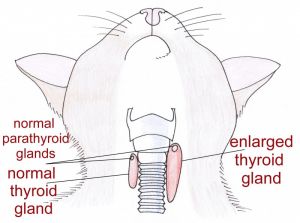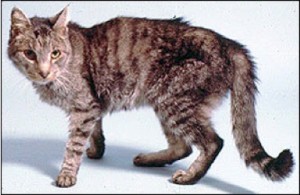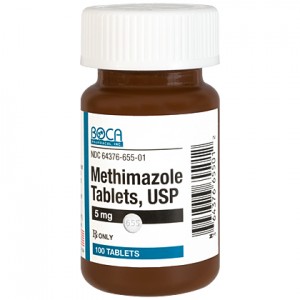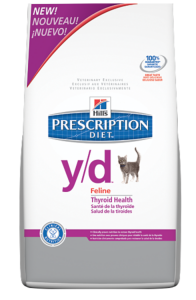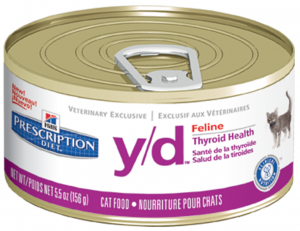What is the thyroid gland?
The thyroid gland is a two-lobed structure located in the neck, and produces several thyroid hormones.
(Image courtesy of Animal Emergency & Referral Center of Minnesota; www.aercmn.com)
The primary function of thyroid hormones is to control the rate at which cells function. Excess thyroid function (hyperthyroidism) is one of the most common diseases diagnosed in cats 8 years of age or older.
What does hyperthyroidism in cats look like?
Common manifestations of hyperthyroidism include:
- Poor hair coat quality
- Aggressive or “cranky” behavior
- Weight loss
- Intermittent vomiting
- Increased appetite
- Increased production of feces / diarrhea
- Patchy hair loss, failure to groom, or excessive grooming
- Increased water consumption
- Increased urine output
- Restlessness and/or nervousness
- Increased vocalization
- Increased respiratory rate
- Increased heart rate
- Heat avoidance
(Photo courtesy of Mark Peterson, DVM, DACVIM; www.animalendocrine.com)
The above picture shows the typical appearance of a hyperthyroid cat. Please note the skinny body composition and the unkempt hair coat.
We don’t know exactly why cats develop hyperthyroidism. Approximately 80% of affected patients simply produce too much hormone (hyperplasia), while 15% of hyperthyroid cats have a non-cancerous thyroid tumor (adenomas). Only 3-5% of hyperthyroid cats have a cancerous thyroid tumor (adenocarcinomas).
How is hyperthyroidism diagnosed?
The diagnosis of hyperthyroidism is relatively easy, and is based on results of non-invasive blood tests performed by primary care veterinarians. Most hyperthyroid cats have elevated levels of a hormone called total thyroxine or tT4. Occasionally some specialized tests are needed to make a definitive diagnosis, and these may include:
- Free thyroxine (fT4) level
- T3 suppression test
- Thyroid scintigraphy
Evaluation by a board-certified veterinary internal medicine specialist and potentially a board-certified veterinary radiologist can be invaluable for those patients who are challenging to definitively diagnose.
How is hyperthyroidism treated?
Four treatments are available for managing hyperthyroidism in cats, and each has advantages and disadvantages. Consultation with a board-certified veterinary internal medicine specialist may be instrumental in determining the best treatment for your cat. Hyperthyroid cats that are not treated will become progressively sicker, and some complications of this disease (i.e.: high blood pressure, acute blindness, a heart muscle condition called hypertrophic cardiomyopathy) can be deadly. Without therapy, benign thyroid tumors can even potentially transform into cancerous lesions. Happily those cats that are successfully treated will either be cured or return to a high quality of life.
Radioactive Iodine Therapy
Radioactive iodine therapy is considered the gold standard for the treatment of feline hyperthyroidism. Iodine is a primary component of thyroid hormones, and it is concentrated in the thyroid gland. Radioactive iodine destroys abnormal thyroid cells, and thus is an extremely effective treatment that cures hyperthyroidism quickly.
Indeed hyperthyroidism almost never recurs after radioactive iodine therapy.
Sophisticated equipment and facilities are needed to safely and properly perform radioactive iodine therapy, and thus treatment should be performed by a board-certified veterinary internal medicine specialist. Patients are typically hospitalized until the level of radioactivity decreases to a safe level as determined by your respective state’s radiation control office (typically ~5 days; may be up to 3 weeks). Parents can’t visit their pets during this hospitalization period, but please have no fear! All cats are cared for compassionately during hospitalization, as they are provided with their preferred diets and environmental enrichment until they are discharged to their families. While this procedure does require an initial substantive financial investment, the need for recheck examinations is minimal; thus there is limited additional financial expense after radioactive iodine therapy. The other treatments described below have extensive follow-up requirements, making all treatment options very similar in cost.
Anti-Hyperthyroid Medication
A common treatment option in the United States is administration of a medication called methimazole (Tapazole®, Felimazole®).
This drug prevents the thyroid gland from secreting thyroid hormones, but does not cure hyperthyroidism. Administration of this medication simply helps to continually manage the condition. The major disadvantages of this drug are the need to consistently administer a daily oral (by mouth) medication to cats and the potential side effects. Relatively uncommon side effects include vomiting, loss of appetite, excessive scratching, and decreases in red blood cells and white blood cells. Although these side effects are alarming, they are are reversible if the medication is discontinued.
Cats who are treated chronically (months to years) with methimazole can develop very large thyroid tumors, and their hyperthyroidism can become very challenging to regulate. Indeed some cats even become completely resistant to methimazole therapy! Follow this link to see a video showing continued growth of thyroid tumors despite methimazole therapy (http://youtu.be/zCRMj5dmODA; video courtesy of Advanced Veterinary Medical Imaging; www.avmi.net)
Surgery to Remove an Abnormal Thyroid Gland (Thyroidectomy)
An abnormal lobe(s) of the thyroid gland can be surgically removed, and surgery resolves hyperthyroidism quickly. While surgey can potentially cure cats, negative aspects of surgery include a requirement for general anesthesia, the low incidence of decreased blood calcium levels after surgery, and the potential for recurrence of hyperthyroidism if other thyroid tissue/lobe becomes hyperactive.
Nutritional Management
As mentioned above, excessive production of thyroid hormone by the thyroid gland is the hallmark feature of feline hyperthyroidism. Thyroid hormone production requires absorption of iodine obtained from a diet. Studies have shown the hyperthyroid cats have over-active metabolic pathways leading to increased iodine uptake by the thyroid gland and thus increased thyroid hormone production. As a result of these findings, a prescription diet (Hill’s Prescription Diet® Y/d®) was formulated based on the hypothesis that feline hyperthyroidism can be managed nutritionally by limiting the amount of dietary iodine available for production of thyroid hormones.
Three studies have documented the safety and efficacy this diet as the sole management in cats with hyperthyroidism. Concentrations of thyroid hormones returned to the normal range within 8-12 weeks of feeding only this type of iodine-restricted diet.
Effective nutritional management of hyperthyroidism requires cats receive absolutely no other food or treats…period!
Feeding different foods while receiving the iodine-restricted prescription diet negates the benefits of the prescription diet. An iodine-restricted diet should not be fed to kittens or pregnant queens, as these populations require higher levels of iodine than that found in this prescription diet. No adverse effects of nutritional therapy have been documented to date. With that being said, progressive growth of thyroid tumors is expected on a low iodine diet since the thyroid tumors remain and continue to grow with time.
What are potential complications of treatment of hyperthyroidism?
Thyroid hormones help regulate metabolism. When too much thyroid hormones is produced, a patient’s metabolic rate is increased. A common manifestation of increased metabolism is enhanced blood flow to the kidneys, thus making them work better! As mentioned earlier, hyperthyroidism is most commonly diagnosed in older cats, and these geriatric patients often have concurrently deteriorating kidney function.
Hyperthyroidism can mask chronic kidney disease – it can make abnormal kidney function look normal!
With treatment, metabolic rates return to normal, thus potentially unmasking abnormal kidney function. For this reason, pretreatment with methimazole is recommended prior to surgery or radioactive iodine therapy, as these interventions are not reversible. If decreasing thyroid hormone levels unmasks chronic kidney disease, a permanent form of treatment should generally be avoided. If thyroid hormone levels decrease and the kidneys show no signs of concurrent chronic disease, then a permanent treatment like radioactive iodine therapy is an option.
The take-away message about hyperthyroidism…
Hyperthyroidism is a relatively common disease diagnosed in older cats. There are several ways to treat this disease, and consultation with a board-certified veterinary internal medicine specialist can be very helpful in determining the best treatment modality for your cat. Similarly consultation with a board-certified veterinary surgeon may be very helpful is surgery is deemed most appropriate.
To find a board-certified veterinary internal medicine specialists, please visit the American College of Veterinary Internal Medicine.
To find a board-certified veterinary radiologist, please visit the American College of Veterinary Radiology.
To find a board-certified veterinary surgeon, please visit the American College of Veterinary Surgeons.
Wishing you wet-nodes kisses,
cgb


